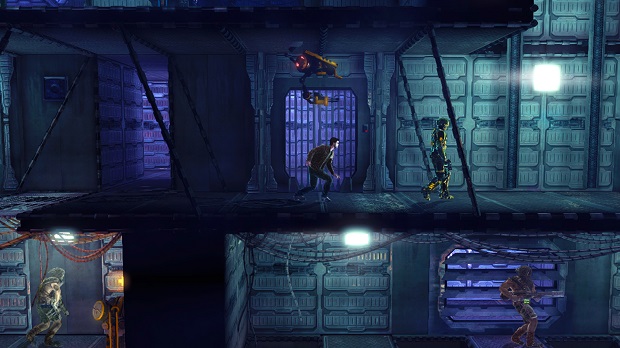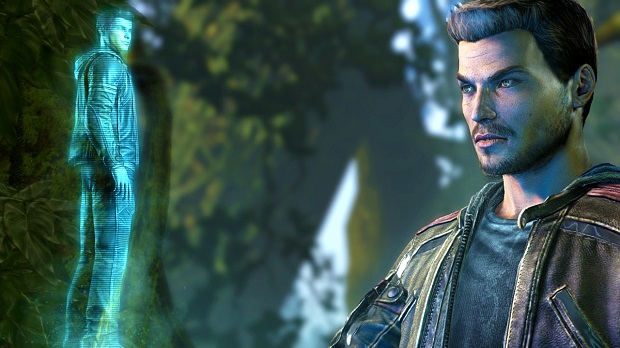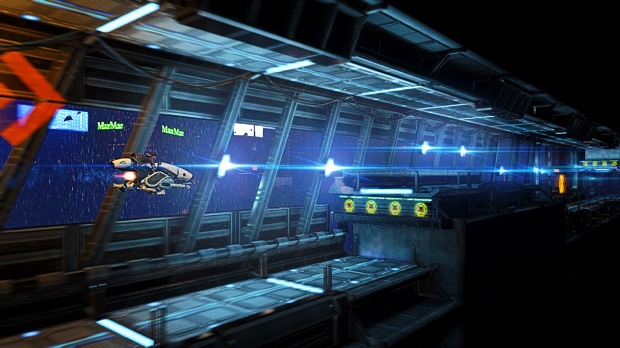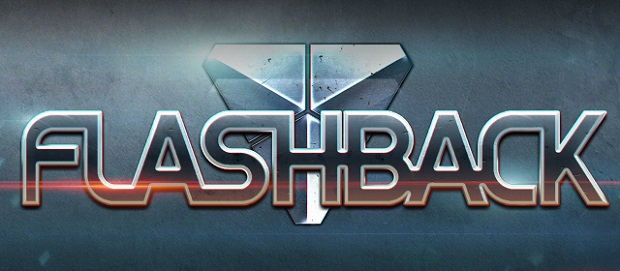I remember Flashback’s original release with fond memories, even if I couldn’t even get past the first section of the game. In 1992 I was six years old, I’d been playing on my Master System II for a good couple of years and we had just gotten an Acorn A3010. It came with a floppy disc for a game called Flashback, of which I knew nothing about, playing it simply because it came with the newly-purchased machine. However, that started the ball rolling for something that still hasn’t stopped, and in fact is still gaining momentum to this day.
Flashback was my very first PC game.
As I mentioned, I couldn’t even get past the first section of the game. I wasn’t used to the controls of PC games – instead accustomed to the frantic one-button action of various Sonic games – but the gorgeous colours and the fluid nature of the animation, thanks to the rotoscoping technology, absolutely blew me away. I must have played the first section of the game a hundred times, if not more, and I couldn’t get enough of it. Even back then I could tell that Paul Cuisset had created something special, not just in the visual department, but in the storytelling department too. I’m not going to suggest that the story was mind-blowing – from the small parts I experienced it was passable but not great – but this was a time when story-driven meant jumping on enemy’s head just because the game told us to; Flashback was so much more than that.

In April of this year it was announced that VectorCell, the company founded by Paul Cuisset himself, would be reassembling some of the team that worked on the original Flashback and developing a remake of the game for Xbox LIVE Arcade, PlayStation Network and Windows PC. This was met with excitement from myself, partly because I would get to see a remake of a game that started my love of PC gaming, but also because, after years of playing games, I might actually be able to make it past the first 25 minutes. Huzzah!
The original Flashback felt kind of like a point-and-click adventure game: even though you could control the character directly, it still had many of the tropes of the then more popular genre. The 2013 remake is no different in the sense that you’ll find yourself moving around the 2.5D world in an attempt to find various keys, keycards, and other items that will open doors and allow you to progress further into the game. The story is very linear too, which normally would be a bad thing but seeing as the developers are trying to recreate and update a game that was essentially a point-and-click adventure, it fits, and doesn’t feel out of place at all. Of course, the game has taken on a much more action-orientated vibe, but that’s down to the fact that you have more buttons at your disposal on modern input devices, not to mention multiple analog sticks. The difference between the controls of the two versions is obvious, but playing the remake and then going back to the 1992 version (which is also included with the game), will result in many deaths as you try and use some of the new controls in the old game, and vice-versa. It’s not an easy thing to do, but it’s interesting to experiment with.
The plot of the remake of Flashback is as paper-thin as the original was, appearing to take more than just a little inspiration from films such as Total Recall and Blade Runner. You play the game as Condrad B. Hart, an agent for the Galaxia Bureau of Investigation (GBI) who has wiped his own memories for reasons he can’t – obviously – remember. You have to traverse the different sections of the game piecing bits of Conrad’s memory together in the hope of figuring out why he wiped his memory, what’s happening, and how he can stop it. The story can be quite confusing at times, but since the whole thing is supposed to be about the loss of memory, it almost feels intentional.
The voice-acting, for the most part, is fine and does its job, but it’s nothing to write home about. Conrad will constantly pour out cheesy one-liners as if the part of his memory that tells him we’re no longer in 1992 has also been erased. Some aspects of the dialogue are genuinely humorous though, and some parts also appear to reference the fact that they’re in a video game, which always gets a few laughs from me. As a remake of a 1992 game, the story was never going to be the strong point without a complete rewrite, which would have taken away from the charm of it. In fact, it’s commendable that the team have only touched it where they thought they had to.
The controls used to navigate through the world of Flashback are very similar to any other Xbox LIVE Arcade/PlayStation Network/Windows PC title that utilises a 2.5D viewpoint, in that you’ll be using the left analog stick to move the character around the game world, and the right analog stick to aim his weapon (which now has a complete 360 degree range of motion, instead of the left and right of the original). The rest of the controls are similar to the original Flashback game in the sense that the ‘A’ button (on the XBLA version) makes Conrad perform a single jump step, and that you have to push the left analog stick upwards in order to make him jump to grab ledges. For players of the original game, it will feel quite natural – especially if you’ve replayed it recently – but players that are more used to a modern control scheme may find it difficult to get used to pressing ‘Up’ to jump instead of just always using the ‘A’/’X’ button, especially when you’re asked to run and jump, both of which use the same analog stick and is almost asking you to press left/right and up at the same time. Most players will get there eventually, and you’ll be platform hopping with the best of them, but it can take some getting used to.

One of the new aspects of Flashback, and something that was hugely welcomed by myself, is the inclusion of a levelling system. Basically, anything you do in the game will net you experience points; collect enough experience and you’ll gain a level that will give you three skill points to assign to whichever attributes you wish (either Accuracy, Technology or Stamina). This enables you to make each playthrough slightly different based on where you put the skill points, or even if you make it to as high a level depending on whether you’re doing a speed run or a normal playthrough. It adds an element to the game that the developers didn’t need to include, but did so anyway, increasing the value of the title even more.
On top of the fact that you get the original Flashback as well as the remake, there’s plenty of replay value to make it a worthwhile purchase, even for people that are sitting firmly on the fence. For a start, dotted throughout each of the levels are hidden “Morph Eyes”. Collecting all of these doesn’t net you anything special, aside from the admiration of others (possibly), and more experience points, but it’s always good to have something else to do in a game world, giving you the choice of whether you want to collect everything you can or just run through it at speed. Speaking of running, in the Statistics menu there’s an option tracking the World Speed Run. This gives those people that love to speed run competitively the chance to pit themselves against one another. The leaderboard even shows ‘Speed Run’ times so, if you’re good enough, you can let the entire world know just how much of a Flashback elite you are. It’s not something for me; I prefer to take in everything the world has to offer (which is why the World Exploration statistic, allowing you to track whether or not you’ve visited every area in the game, was much more up my alley), but having the option to do a speed run, should you so wish, is nothing to be sniffed at.
The 1992 version of Flashback was critically acclaimed for its use of rotoscoping. That was state of the art then, and still actually holds up quite well today – however, there was no way that kind of technology would have worked for the remake. To that end, VectorCell have made good use of the Unreal 3 Engine. The models look a little bland, and there’s only a couple of enemy types throughout the entire game, but the animations are well executed and I saw very little, if any, of the Unreal 3 Engine’s characteristic texture popping. Sure, it might not be as visually eye-catching as its 20-year-old predecessor, but there’s absolutely nothing wrong with how they’ve chosen to go about it this time around.

VERDICT: The remake of Flashback is a game that deserves to be played, whether you played the original game back in 1992 or not. The story could have done with a little bit more fine-tuning and the actor playing Conrad would have done a bit better if he hadn’t been channelling every single cheesy 80’s movie star simultaneously, but the gameplay, the bit that’s most important when it comes to an actual game, is enjoyable from beginning to end.
It’s not a long game, clocking in at only three or four hours (depending on whether you choose to fully explore the world and collect all of the Morph Eyes) but it’s a three or four hours that you probably won’t mind playing again from time to time. I’d love to see VectorCell make more games in this universe, and expand on the story a little bit – something that they never really did properly the last time around (Fade to Black doesn’t count; it’s a totally different style), and hopefully Flashback will be successful enough to allow them to do just that.

GOOD. A game that scores 7/10 is worthy of note, but unworthy of fanfare. It does many things well, but only a few of them incredibly well and, despite a handful of good qualities, fresh ideas and solid mechanics, it fails to overwhelm.






